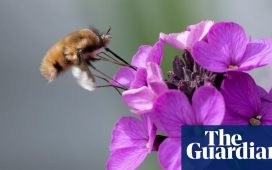Rainbow-hued bee-eaters breeding on the Norfolk coast this summer and three rare black-winged stilts fledglings in Yorkshire are an “unmissable sign” that the nature and climate emergency has reached Britain, according to conservationists.
Birdwatchers are flocking to north-east Norfolk to see the bee-eaters, a colourful rare visitor from Africa and southern Europe, after seven birds were spotted close to Cromer by a local birder.
Several bee-eaters have been observed making nest burrows in a small sand quarry near the coastal village of Trimingham, raising hopes they will breed successfully.
Bee-eaters did not breed in Britain between 1956 and 2001 but this is now the sixth nesting attempt this century, with birds nesting in County Durham in 2002, Herefordshire in 2002, the Isle of Wight in 2014, Cumbria in 2015 and Nottinghamshire in 2017, when nests in a quarry failed because of bad weather.
“These seven bee-eaters are certainly the most colourful and exciting birds you can see in the UK right now,” said Mark Thomas of the RSPB. “While an incredible sight, we mustn’t forget that the arrival of these birds to our shores is due to changes to our climate and subsequent pressures on wildlife both here and across the globe.
“Pushed northwards by climate change, these exotic birds will probably become established summer visitors in the future, having been an early and unmissable sign in the past two decades that the nature and climate emergency has reached our shores.”
The starling-sized bee-eaters have red backs, blue bellies and yellow throats, and can be seen feeding on bees, dragonflies and other flying insects which they catch in mid-air.
At Potteric Carr nature reserve in Doncaster, three black-winged stilts this week fledged from what is believed to be the most northerly nest in Britain for a wading species, which is rare in this country and does not breed here every year.
Andy Dalton, operations manager at Yorkshire Wildlife Trust, said: “It’s been a tense wait but we’re overjoyed. Potteric Carr is a green oasis on the fringe of Doncaster, surrounded by busy roads and industrial development – the conservation work we do here has a significant impact for wildlife including rare species like black-winged stilts.”
Danny Heptinstall, director of policy and partnerships at Yorkshire Wildlife Trust, warned that nature-rich places must be protected and restored at a large enough scale to ensure that species forced north by global heating can find refuge in Britain.
“The only reason we’ve got black-winged stilts breeding at Potteric Carr is because we have a fantastic landscape-scale nature reserve of a couple of hundred hectares with ambitions to extend it further. If we don’t create the habitat for these species in the UK they will have nowhere to go,” said Heptinstall.
“It’s positive, exciting and a brilliant endorsement of the work we’ve been doing at Potteric Carr but it’s also an alarm call. The flip-side is what we are losing at the same time. In Yorkshire we’re looking anxiously at our seabird populations, including kittiwakes, fulmars and puffins.”
Of the UK’s 25 breeding seabird species, 24 are assigned red or amber status on the birds of conservation concern list, meaning they are at risk of local extinction. As sea temperatures rise, fish stocks move north or disappear, reducing the breeding success of seabirds farther south and compelling species to shift to where they can find food.
*The RSPB and the North-East Norfolk Bird Club have set up a car park and viewing area in a large grass field off Gimingham Road near Trimingham so the bee-eaters can be watched without admirers disturbing their nesting attempts.






